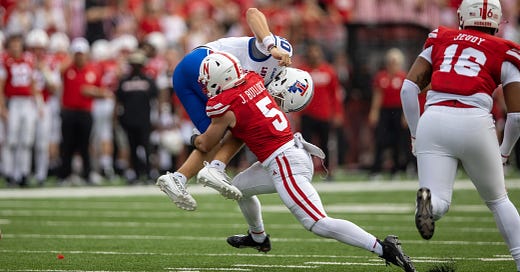Glossary of Terms1
Link to Viewable Charting Sheet2
DRIVE 1
6 Plays, 2.33 Yards Per Play Allowed
83.3% Success Rate
0 Explosive Plays Allowed, 0 Havoc Plays Allowed
There’s a bit of a feeling out portion to open the game, with Nebraska coordinator Tony White trying a bit of everything on the first drive. He plays Cover 4 with only three rushers on first down, then switches to press-man coverage and a heavy-line blitz on second down. On third down, he lines up in a four-man front and drops into zone coverage again. Louisiana Tech throws a quick screen or pass on its first four plays, so they’re content to just take the temperature, too, and are able to pick up a first down on their one successful play of the drive when star receiver Smoke Harris takes a bubble screen 10 yards on run-after-catch.
White again drops eight into coverage on the next first down, this time playing Cover 6, which features two deep coverage players to one half of the field and another deep player to the other half. The Bulldogs pick up some yardage on a swing screen against it, with the secondary dropping deep. White then switches back to man coverage on second and third downs, with NU stuffing a run with 6-0 front blitz and the four-man front generating a rush again on third down. So the Blackshirts formula that drive went like this: Drop 8 on first down, blitz on second down, four-man rush on third down. It’s a theme that will continue.
DRIVE 2
4 Plays, 2.0 Yards Per Play Allowed
75% Success Rate
0 Explosive Plays Allowed, 1 Havoc Play
The strategy stays the same: White plays Drop 8 zone coverage on the next two first downs (a Nebraska penalty in-between the plays gives LTU a first), and White brings an A gap blitz on second down, which Louisiana Tech completes a short pass against.
On third and 3, the Blackshirts come out in a pass-rush package, a four-man front composed of linebackers Jimari Butler (green arrow), Chief Borders (orange arrow), and MJ Sherman (blue arrow), who have been three of NU’s best pass rushers in the early going:
Seeing that look, Louisiana Tech calls a timeout. After the break, the Huskers come out back in their base personnel but are still in a pressure look. But they do the opposite, dropping eight into coverage:
The cat-and-mouse game went like this: White showed a blitz look with a pass-rush package before the timeout and is showing a blitz look again. LTU also knows that on the two previous third downs, White has brought four and played base coverage. So they’re thinking at least four rushers. But all three mugged up NU backers at the line drop into coverage, making it neither base rush nor pressure and giving the QB something he’s not expecting to end the drive.
DRIVE 3
6 Plays, 2.6 Yards Per Play Allowed
66.6% Success Rate
0 Explosive Plays Allowed, 1 Havoc Play
Entering this drive, Louisiana Tech has run 10 plays, nine of which have resulted in throws (either as pure passing plays or RPOs), so White goes pass coverage heavy entering Drive 3. Three of the first 4 plays on this drive are Drop 8 deep zones, the one exception being a third and short where NU plays tight press man and brings two of its safeties into the box.
But this is the drive where La. Tech starts running the ball. The Bulldogs were running little quick-screen tag run-pass options on a majority of their plays, and these would start resulting in handoffs with NU playing with lighter shells and more safeties deep. They also just started calling some designed runs. On the first third down of the series, Nebraska lines up in a four-man front by bringing their Jack linebacker down, as it had on all but one of its previous third downs. LTU caught on to this and ran a Midline option to convert, reading the 3 technique interior defensive tackle, with the quarterback keeping for a first:
This is a good call against a four-man surface, and not one you make unless you know that’s what you’re getting. With the aggressiveness of Nebraska’s defensive line and one-gap scheme — which requires getting upfield aggressively into individual gaps — I’m surprised teams haven’t done more reading of NU’s front. Colorado tried it a bit but wasn’t super interested in running the ball and wasn’t very good at it. Minnesota and NIU have more traditional pro-style attacks that don’t run their QBs. But I expect to see more teams (possibly even Michigan with a mobile quarterback) start utilizing reads to counter the speed with which NU’s defenders are getting up the field.
Keep reading with a 7-day free trial
Subscribe to Black 41 Flash Reverse to keep reading this post and get 7 days of free access to the full post archives.






